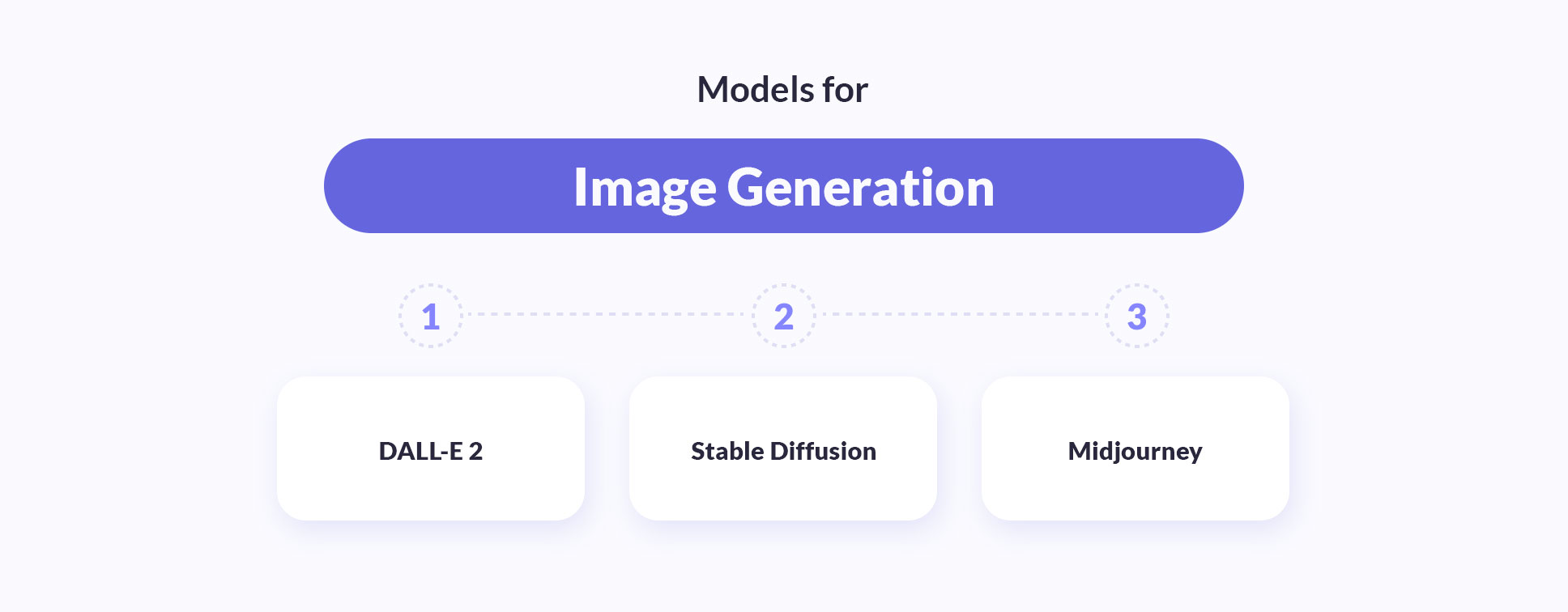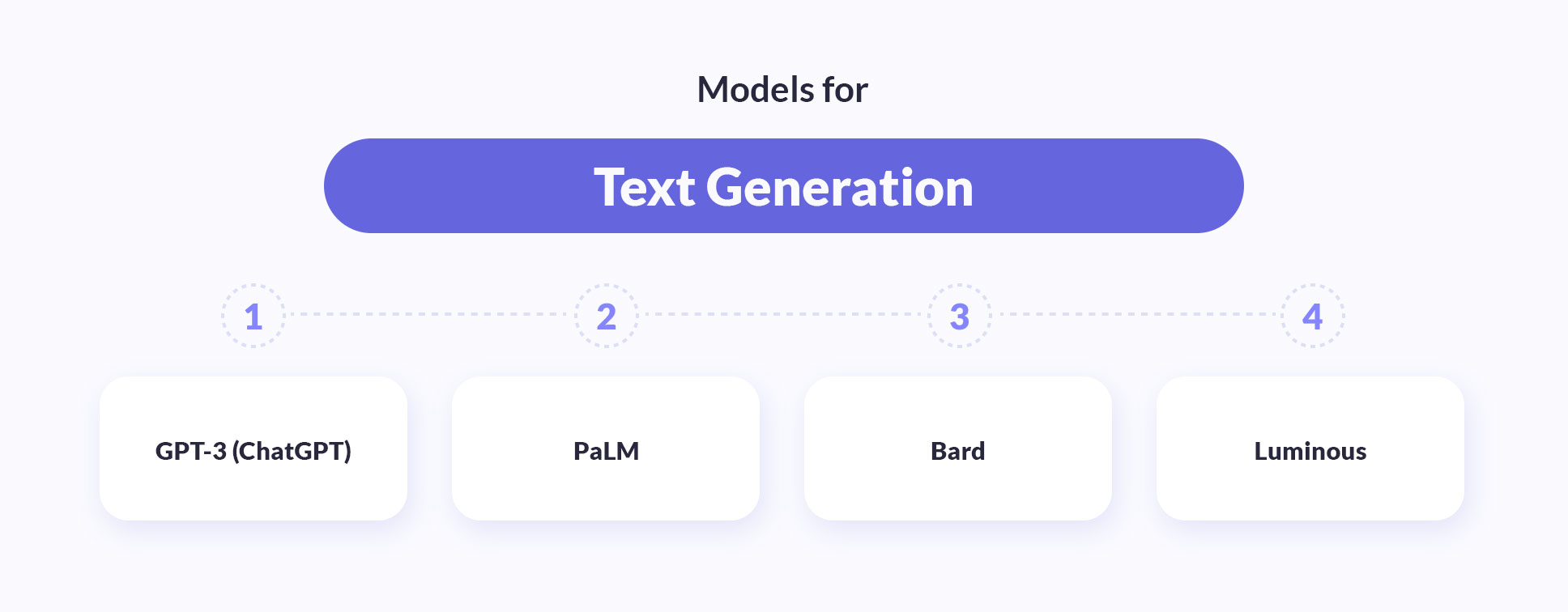Here’s a fact: OpenAI's ChatGPT acquired 100 million visitors just two months after its launch. This tool uses Natural Language Processing (NLP) technology, which enables it to understand and create human-like text.
You can automate tasks such as handling customer complaints, creating content, marketing copy, sentiment analysis, and product development with this tech. Some NLP model technologies that have evolved recently are GPT-3, BERT, Bard, and LaMDA.
In this article, you will learn about several large language models for text – LLM and NLP, and image generation. You will also learn their architectures, pros, cons, and challenges concerning their benefit to your business.
In this article:
NLP vs LLM vs DLM
What is the significant difference between NLP and LLMs, along with DLMs?
Natural Language Processing (NLP) refers to vast research into methods for creating, interpreting, and comprehending human language. Some key NLP models’ tasks are translating text from one language to another, text classification into predefined classes, and language understanding (audio-to-text form).
Large Language Models (LLMs) are deep neural networks programmed to produce or comprehend language using enormous amounts of text data. Some popular LLMs are LaMDA, PaLM, BLOOM, GPT-3, and RoBERTa. These tools can generate texts from their training data.
DLMs (Diffusion LMs) expand on LLMs by adding different types of media in addition to text, such as pictures, audio, and video. For instance, if you need to generate a picture, a DLM would ask for text input image description to produce the image.
Let’s briefly compare DLM, NLP and LLM based on the main characteristics like scope, functionality, complexity, etc.
Models / Characteristics | Natural Language Processing (NLP) | Large Language Models (LLM) | Diffusion Language Models (DLM) |
Scope | Focuses on understanding and manipulating human language for various text-based or language tasks | Specializes in generating and comprehending text using massive datasets | Extends beyond text to include multimedia content like images, audio, and video |
Functionality | Performs language tasks like text analysis, named entity recognition, and machine translation | Generates human-like text and performs complex text comprehension | Generates diverse content types, such as images and audio, from text descriptions |
Complexity | Generally simpler, using algorithms like decision trees and basic machine learning techniques | Highly complex, requiring deep neural networks and substantial computational power | Even more complex, integrating multiple types of data and requiring advanced processing capabilities |
Applications | Used in sentiment analysis, risk assessment, and enhancing customer service | Powers chatbots, virtual assistants, and automates content creation such as articles and report, text summarization | Used in creating realistic images from text (e.g., DALL-E 2), generating audio content, and developing interactive media applications |
Challenges and Ethical Considerations | Faces challenges with accuracy and context understanding in varied languages | Prone to biases and misinformation due to reliance on large datasets | Ethical concerns include the potential for misuse in creating deceptive media and the high computational cost |
Architectures of major LLMs

Each LLM has an architecture based on deep learning techniques. These LLMs know sentiment analysis, which lets them understand the tone of your text data and respond accordingly.
Now, let’s see the architecture of some transformer-based LLMs and other major language models.
Transformer architecture (GPT models)
Launched in 2017, Transformer Architecture is one of the deep learning models that works on encode-decode patterns. It serves as a base for major AI driven solutions like GPT-2, GPT-3, GPT-4, and GPT-Neo.
GPT, or generative pre-trained transformer, belongs to the Transformer family of models and is an advancement in NLP technology. It enables the model with natural language generation and processing human language.
Some of the prominent features of the transformer models are:
Encoder-decoder structure (enables the parallel processing of output and input sequences).
Attention mechanism rather than recurrence (enables the capture of words regardless of where they appear in a sequence).
Multi-headed self-attention mechanisms (permits the model to concentrate on various input sequence segments).`
Position embeddings (acknowledge the input sequence's word order).
Ready to bring your business to the next level?
Experience the power of the latest AI solutions with our AI-powered app development services!
BERT architecture
After the launch of Transformers Architecture, Google introduced BERT (Bidirectional Encoder Representations from Transformers) in 2018.
BERT uses the surrounding text to understand the intent and context of the text. Many models, including RoBERTa and ELECTRA, are based on BERT.
Here are some features of BERT Architecture:
Encoder-only transformer based on neural networks (emphasizing only comprehension of input text data).
Masked topic modeling and next-sentence accurate predictions.
Learns bidirectional representations by conditioning on left and right contexts.
Models for image generation

DALL-E 2
DALL-E 2 is a text-to-image generation model developed by OpenAI. It is a revised version of its previous deep learning version, DALL-E.
Strengths: DALL-E 2 produces pictures as per the input written descriptions. A big thanks goes to its control through text, which allows complex scene generation. You can create images that look real and are aesthetically pleasing.
Limitations: The model requires interaction between computers and needs strong GPUs to operate effectively. If you are a big corporation that requires image generation in volumes, you need to pay a hefty amount.


Thank you for Subscription!
Stable Diffusion
Stable Diffusion is an open-source model that produces captivating visuals from texts. Through diffusion techniques, this model offers you a unique method for tackling issues.
The best part? You can use it with both local GPUs and cloud computational resources services.
Strengths: The model is versatile for generating various images from text. Also, you can customize it as per your requirements. This model’s basic plan is $9/month, making it a good investment for small businesses.
Limitations: Sometimes, it gives less coherent results. Also, you need to tune parameters and configurations to get an effective information extraction, which can waste your time and effort.
Midjourney
Midjourney was introduced in 2022. It generates images using a generative design engine. This AI tool uses Google Cloud infrastructure to produce photorealistic images in a few keystrokes.
Strengths: Midjourney produces unique images and offers a simple interface that even a beginner can use.
Limitations: You get minimal adjustments and customizations in the images you generate. Further, images are public. Additionally, you need a Discord account to use Midjourney.
Models for text generation

GPT-3 (ChatGPT)
Almost half of all companies (nearly 49%) use ChatGPT in their business operations. It is enough to show how businesses are embracing this new emerging tech.
OpenAI's GPT-3 is one of the most popular large language models trained on 175 billion parameters. It runs on Microsoft's Azure, which is outfitted with A100 GPUs.
ChatGPT is a conversational AI built on the GPT-3 platform, which provides text-generated answers as per your prompts.
Strengths: It produces contextual understanding and human language, thanks to its huge pre training data. You can use it for various general and specific tasks: content creation, email writing, business copy, and writing product descriptions.
Limitations: Despite GPT-3 being trained on massive data, it sometimes generates irrelevant text. Furthermore, you need to cross-check facts, as it is still in the evolving phase.
PaLM
Developed by Google Brain and DeepMind, PaLM (Pathways Language Model) was trained on 540 billion parameters. It can do numerous tasks for your business, including text generation, images, code generation and analysis, language translation, rewriting, and more.
Strengths: The model handles a variety of data formats, including textual data, visual material, and code snippets. This multimodal can make way for cutting-edge applications spanning a variety of jobs across numerous industries.
Limitations: PaLM requires high computational costs for its extensive training process and inference. Consequently, there’s a limit to the availability of PaLM.
Bard
Google launched Bard in competition with ChatGPT in 2022. It is a conversational AI chatbot based on PaLM. And since it was trained on Google's enormous data, you get more logical and appropriate answers for free.
Bard leverages Google's cloud infrastructure, ensuring cybersecurity and privacy for its users.
Strengths: There are direct responses to user inquiries, which improves the effectiveness and efficiency of interactions. You can use it to create content marketing campaigns, product plans, and code.
Limitations: Bard has a smaller model size and reliance on search, indicating less human-like conversational capacity. Sometimes, it can be wrong with facts and dates.
Luminous
Aleph Alpha, a German AI startup, created the large language model (LLM) Luminous. It included up to 20 billion parameters and was trained on an enormous dataset of text and code.
The model generates and understands human language with precision.
Strengths: On numerous NLP benchmarks, it ranks among the best models. With the help of its intensive training and training parameters, it comprehends and produces text like a human being.
Limitations: It is a work in progress, but still getting some recognition, like GPT-3. Further, it implies that it may not be able to handle complex tasks and prompts.
Challenges facing Large Language Model (LLM)
These machine learning models are not always good. Even though this technology can generate human language, it has some drawbacks, posing some challenges..
As a business, you must be aware of these challenges and be mindful of them while leveraging the help of the technology.
Bias and harmful content
LLMs can reinforce and magnify societal biases found in the training data. If adequate protections aren't there, LLMs produce openly damaging or abusive content, including hate speech, violence, misinformation, and spam.
However, these hazards can be controlled by data filtering, human-in-the-loop learning, and content monitoring. But eliminating bias and harm, nevertheless, is quite difficult.
Misinformation
The fact-checking and accuracy verification still needs work. And since these models generate human-like text, it is sometimes hard to spot false information.
For example, if you want to create news reports, you may find the surface can seem genuine and true, but most of the time, it isn’t.

You may be interested
AI And Predictive Analytics: A Powerful Combination For Business Growth
Discover how AI and predictive analytics team up to help businesses grow by providing valuable insights and making smart decisions.
Continue readingAccessibility
LLMs are based on deep learning algorithms capable of amazing things, but businesses without the appropriate computational linguistics resources may be unable to use them.
This is because a vast amount of computational resources, including GPUs and TPUs, in huge datasets is required to train a language model. So, higher costs can be a concern for small businesses.
Legal and ethical concerns
The use of LLMs brings up difficult legal and ethical issues because they can generate human-like text. Some major concerns are copyright issues, plagiarism, authenticity, and accountability.
Therefore, it is important to make strict laws for using output generated via these models.
Environmental impact
Training a single AI model can produce approximately five times as much carbon dioxide equivalent (626,000 pounds) throughout its lifetime as the typical American car.
Energy use and the resulting emissions are worrying aspects. Therefore, the artificial intelligence (AI) community must work toward more eco-friendly training techniques and investigate ethical issues.
Ongoing research required
As you know, the era of LLMs is evolving and requires more research. For example, maybe AI can generate texts, but it hardly knows its meaning.
Also, data and fact-checking need more work.
Pros and cons, infrastructure and costs of major LLMs
LLMs are at a ripe age. They are developed using various programming languages that can perform NLP tasks, mimicking a human. Over time, they will change and become better due to inevitable changes in the coding languages on which they are developed.
However, it makes sense to learn about the pros and cons of major LLMs and their infrastructure and costs if you are using them in your business.
Language Model (DLM, LLM, and NLP) | Pros | Cons | Pricing |
DALL-E 2 | High -quality and accurate images from textual descriptions | Only supports the English language for input | $0.13/prompt |
Stable Diffusion | Available as an open-source tool Specializes in creative image generation Runs on consumer GPUs | There's lower coherence and image quality | Starts at $9/month |
Midjourney | It comes with a user-friendly interface Provides a comprehensive analytics dashboard Understands your prompts better | Limits transparency and customization | Basic monthly plan starts at $10 |
GPT-3 (ChatGPT) | Generates fluent and human-like text generation Has a user-friendly and clean dashboard Available as a free app now | Often gives incorrect factual information | Free to use, premium plan is $20 |
PaLM | Provides direct and succinct answers Was trained with enormous Google data Comes with a friendly UI | Generates incorrect or nonsensical text at times | Starts at $0.0005/1000 characters |
Bard | Leverages Google's vast knowledge graph It is free to use and has easy navigation Generates accurate and relevant output | Still needs improvements in fact-checking | Free to use |
Luminous | Achieves state-of-the-art results Provides great outcomes despite being a small language model Strong logical reasoning abilities | It is a proprietary tool that reduces transparency and accessibility | Starts at €0.006 |
Conclusion
Large language models like GPT-3 and DALL-E 2 are based on neural networks. These models showcase the enormous potential of AI to generate eloquent text and creative visuals. Consequently, these NLP systems can boost your business's efficiency when used smartly.
Undoubtedly, there are concerns about ethics, misinformation, bias, and accessibility. That's why LLMs still require human oversight.
Next, if you want to leverage the power of AI in your business, you need NLP applications. From increasing sales to developing software and debugging codes, let AI be your 24x7 assistant.
But implementing AI isn't a cakewalk. There's much misinformation on the internet about using it in your business. Whether you are looking for a large language model development company or require help with implementation or guidance – our artificial intelligence software development services can help.
Geniusee is a group of intelligent IT professionals who handle the tech core of your business while you focus on growing and expanding it.
Learn more about Geniusee’s outsourcing services.

More useful information for you
Top 5 Generative AI Use Cases For Your FinTech Business
Explore the top five practical applications of generative AI that can benefit your Fintech business.
View the articleFAQs
What skills are needed to implement NLP and LLM technologiesls?
You don't need specific skills to use these tools. Usually, NLP and LLM are user-friendly and offer a clean UI. However, you should know how to give the right prompt (input) for the best results.
How fast can you see returns on your investment?
Large language models (LLMs) like GPT-3, Bard, and ChatGPT are free. However, the other large language models work efficiently and have a lower price tag. So, investing in these models will enhance your business in the long run.
Do you need in-house infrastructure to run NLP and LLM models?
Cloud APIs offer access without infrastructure expenditure for most NLP and LLMs. However, there are options to execute models locally through cloud GPU. Only the most demanding applications need a large internal infrastructure.
How do you stay ahead of AI developments in your industry?
You can attend conferences, keep up with industry publications, and participate in online forums. Furthermore, connect with experts, read the latest research, and take online courses to keep your skills up to date.





















